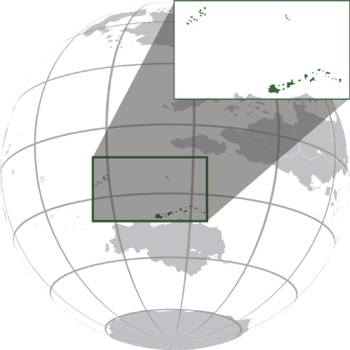Mihi Mai Ra
This article is incomplete because it is pending further input from participants, or it is a work-in-progress by one author. Please comment on this article's talk page to share your input, comments and questions. Note: To contribute to this article, you may need to seek help from the author(s) of this page. |
Federation of Mihi Mai Ra Punaha o Mihi Mai Rā Faiga o Mi'i Mai Laa Fédération de Mihi Maï Ra | |
|---|---|
| Motto: "To tino aria" "To your heart" | |
| Anthem: "E te atua tohingia te kuini" | |
 Mihi Mai Ra (dark green) in Sublustria | |
| Capital | |
| Largest city | |
| Official languages | To Tatou Reo, Le Gagana, Gaullican, Estmerish |
| Demonym(s) | |
| Government | Unitary parliamentary constitutional dual republic |
| Maoe III | |
• Pirima | Te Hari Nui O Nga Moutere E Rima |
| Legislature | Kohikohi |
| Establishment | |
• Arrival of the Eucleans | 1629 |
| 1732 | |
• Dominion | 1910 |
| 1942 | |
| Population | |
• 2014 census | 5,402,981 |
| GDP (nominal) | 2018 estimate |
• Total | $395.780 billion |
• Per capita | $73,252 |
| Gini (2018) | medium |
| HDI (2018) | very high |
| Currency | Pona (£ (MP)) |
| Date format | dd-mm-yy |
| Driving side | right |
| ISO 3166 code | MMR |
| Internet TLD | .mr |
The Federation of Mihi Mai Ra (To Tatou Reo: Punaha o Mihi Mai Rā, Le Ganaga: Faiga o Mi'i Mai Laa, Gaullican: Fédération de Mihi Mai Ra), sometimes referred to as the Coconut or Palm Islands, is a small sovereign island nation situated in the Sublustrian sea north of Valentir. Mihi Mai Ra comprises three island archipelagos: Karawaha, Savo and Whuru. Mihite Society originates from the Araterans who settled the Karwaha and Turu archipelagos with influences from Gaullican, Estmerish and Tagatan cultures.It is one of the most geographically isolated countries in kylaris. This geographic isolation has allowed the growth and development of an extremely varied and rich endemic flora and fauna from giant Kauri to the Weta insects as well as the Kaponga and Kiwi with these latter two being national symbols of Mihi Mai Ra.
Mihi Mai Ra was one of the last places discovered by man, the Karwaha was discovered by the Araterans between 1000 and 1200. The Turu archipelago was discovered even later in the 1400s. The Araterans in Karawaha lived life in Kainga in societal units called hapu. {wp|Maori people|Arateran}} political structure centred around the Ratinga of a given Kainga. Kainga were inhabited year-round instead hapu used land in cycles immigrating to new areas. Population growth, defeat in battle or the death of a Ratinga were all reasons for why a hapu would choose to go look for new lands. This life-style coupled with population growth led many Araterans to leave Karawaha for Valentir in the 1200s and later for Turu in the 1400s.

